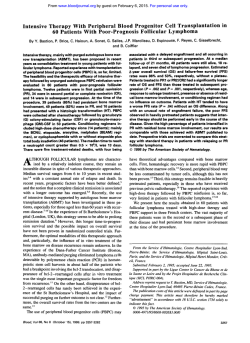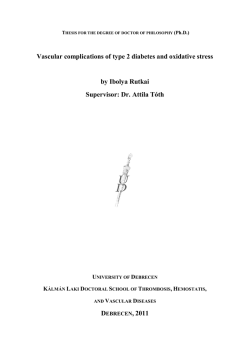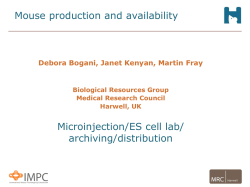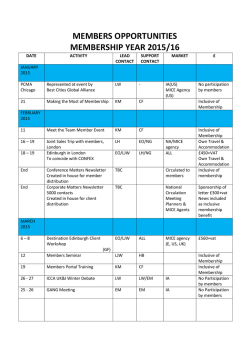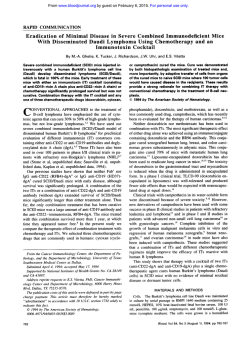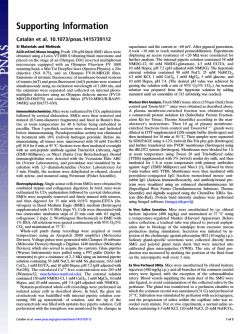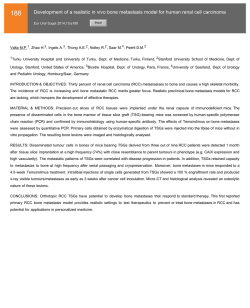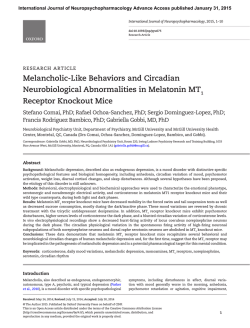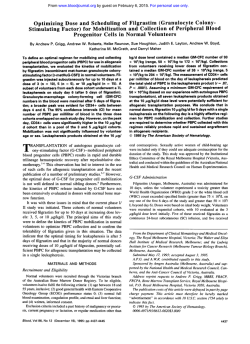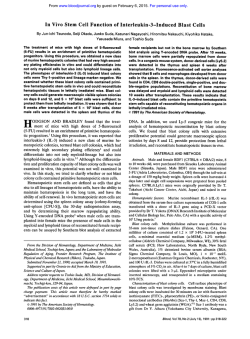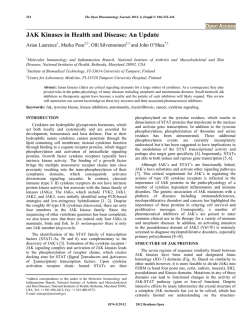
Peripheral Blood Progenitor Cells Mobilized by Recombinant
From www.bloodjournal.org by guest on February 6, 2015. For personal use only. RAPID COMMUNICATION ~~ ~ ~~~~~ Peripheral Blood Progenitor Cells Mobilized by Recombinant Human Granulocyte Colony-Stimulating Factor Plus Recombinant Rat Stem Cell Factor Contain Long-Term Engrafting Cells Capable of Cellular Proliferation for More Than Two Years as Shown by Serial Transplantation in Mice By X.-Q. Yan, C. Hartley, P. McElroy, A. Chang, C. McCrea, and I. McNiece Mobilized peripheral bloodprogenitor cells (PBPC) have been shown t o provide rapidengraftment in patients given high-dose chemotherapy. PBPC contain cells with long-term engraftment potential as shown in animal models. In this study we have further analyzed mobilized PBPC for their ability t o support serial transplantation of irradiated mice. Transplantation of recombinant human granulocyte colonystimulating factor (rhG-CSF) plus recombinant rat stemcell factor (rrSCF) mobilized PBPC resulted in 989’0 donor engraftment of primary recipients at 12 t o 14 months posttransplantation. Bone marrow (BM) cells from these primary recipients were harvested and transplanted into secondary recipients. At 6 months posttransplantation, all surviving secondary recipients had donor engraftment. Polymerase chain reaction(PCR) analysis showed greater than 909’0male cells in spleens, thymuses, and lymphnodes. Myeloid colonies from BM cells of secondary recipients demonstrated granulocyte/macrophage colony-forming cells (GM-CFC) of male origin in all animals. In comparison, transplantation of rhG-CSF mobilized PBPC resulted in decreased male engraftment in secondary recipients. BM cells from secondary recipients, who originally received PBPC mobilized by the combination ofrrSCF and rhG-CSF, were furtherpassagedt o tertiary female recipients. At 6 months posttransplantation, 909’0 of animals had male-derived hematopoiesis by wholeblood PCR analysis. These data showed thatPBPC mobilized with rhG-CSF plus rrSCF contained cells that are transplantable and able t o maintain hematopoiesis for more than 26 months, suggesting that the mobilized long-termreconstituting stemcells (LTRC) have extensive proliferative potential and resemble those that reside in the BM. In addition. the data demonstrated increased mobilization of LTRC with rhG-CSF plus rrSCF compared t o rhG-CSF alone. 0 1995 by The American Societyof Hematology. H were transplanted into lethally irradiated female mice. The primary recipients had greater than 90%donor engraftment at 12 to 14 months posttransplantation.’ BM cells from these animals have been transplanted into secondary and tertiary recipients and the male-derived hematopoiesis is evaluated. IGH-DOSE CHEMOTHERAPY for treatment of solid tumors requires cellular support of bone marrow (BM) cells or peripheral blood progenitor cells (PBPC). BM transplantation (BMT) has been shown to provide long-term durable engraftment of recipients. PBPC transplantation has primarily been performed in the autologous setting, complicating the determination of long-term engraftment of donor cells from endogenous recovery. Mouse models have been used to evaluate the long-term engraftment potential of growth factor mobilized PBPC. Granulocyte colony-stimulating factor (rhG-CSF),’ stem cell factor (SCF),’ and interleukin-l (IL-l)3mobilized PBPC have been shown to provide donor engraftment in irradiated mice for 6 to 12 months posttransplantation. In addition, we have shown that PBPC mobilized by the combination of an optimal dose of rhGCSF plus low doses of recombinant rat SCF have increased numbers of cells with short-term and long-term engraftment potential compared with PBPC mobilized with rhG-CSF al~ne.~,~ A number of studies have demonstrated that serial transplantation of BM cells leads to decreased long-term reconstitution ability and that BM cells from previously transplanted animals have decreased long-term reconstituting ability (LTRA) compared with BM cells from untreated anim a l ~ . Studies ~ . ~ by Harrison et a1 demonstrated that the decline in LTRA was not a function of age of the stem cell^.^^* Moreover, they concluded that the proliferative potential of stem cells was decreased after transplantation, probably because of differentiative pressure on the stem cells. In this study we have evaluated the short-term and long-term reconstituting capacity ofBM cells from mice that were transplanted with PBPC mobilized with rhG-CSF alone or the combination of rhG-CSF plus rrSCF. Male donor mice were mobilized for 7 days with growth factors and the PBPC Blood, Vol 85, No 9 (May l ) , 1995: pp 2303-2307 MATERIALS AND METHODS Mice. Eight- to 12-week-old female and male splenectomized (C57BW6J x DBN2J) F,(BDF,) mice were purchased from Charles River Laboratories (Wilmington, MA). All animals were housed at animal facilities of Amgen Inc (Thousand Oaks, CA) under sterile conditions and were supplied with acidified water. Transplantation. Mobilization of PBPC using BDF, mice has been described previously! Briefly, male splenectomized BDF, mice were treated with rhG-CSF at 200 pgkgld, or rhG-CSF 200 pg/kgl d plus recombinant rat pegylated SCF (rrSCF-PEG) at 25 pg/kg/d for 7 days. Both rhG-CSF and rrSCF-PEG were produced by Amgen Inc.’.’’ BM cells from femurs and tibias were flushed in 2% fetal bovine serum-Hanks’ balanced saline solution (FBSHBSS), washed, and resuspended in isotonic saline containing 1 % bovine serum albumin (BSA). Nucleated cells were counted and transplanted into yirradiated (GI3’, 12 Gyat split dose 4 hours apart) female BDFl mice. From the Department of Developmental Hematology, Amgen Inc, Thousand Oaks, CA. Submitted December 21, 1994; accepted February 8, 1995. Address reprint requests to I. McNiece, PhD, Amgen Inc. Amgen Center, T-I-A-207, 1840 DeHavilland Dr, Thousand Oaks, CA 91320-1 789. The publication costsof this article weredefrayed in part by page charge payment. This article must therefore be hereby marked “advertisement” in accordance with 18 U.S.C. section 1734 solely to indicate this fact. 0 1995 by The American Society of Hematology. 0004-4971/95/8509-0043$3.00/0 2303 From www.bloodjournal.org by guest on February 6, 2015. For personal use only. YAN ET AL 2304 Table 1. Primary Recipients Transplanted With PBPC Mobilized With rhG-CSF or rhG-CSF Plus nSCF l plus SCF 25 pgkgday Injected PBPC (2.5 x 105 LD Cells) + A (5) B (10) + + (I.slr*onyPCRI 1. Whole blood PCR 6 months No. of Cells Factors (sglkgld) X rhG-CSF (200) 52-59 rhG-CSF (200) + rrSCF (25) 105 2.5 2.5 96 Male Positive Time lwks) Cells in Whole Blood 48 >go% >90% Mice reconstituted with PBPC mobilized with either rhG-CSF alone or rhG-CSF plus rrSCF were killed at the times indicated. Results of donor (malekderived hematopoiesis are shown byPCR analysis of whole blood and single colonies picked from BM cultures. BM (0.1-1.0 femur) + Donor Groups (n) 3.SDI& Ivm & thv PCR intron sequence.I4Amplified materials were electrophoresed in 1.5% agarose, Southern blotted, and hybridized to 32P-end-labeledSry or PDGF B receptor internal sequences (25-bp oligos), respectively, with conventional hybridization protocols.I2 An overview of the serial transplantation and analysis is presented in Fig 1. BM (0.1-1 .O femur) + RESULTS PBPC mobilized with rhG-CSF alone (group A) or rhGCSF plus rrSCF (group B) were transplanted into lethally 2xgoorads irradiated mice at 2.5 X IO' low-density cells per animal. 6 months At 48-59 weeks posttransplantation, these mice had greater than 90% donor (male) cells in the peripheral blood (Table I Whole blood PCR 1 1) and 81% (group A) and 98% (group B) donor-derived GM-CFC in the BM.* The BM cells from these animals Fig 1. Experimental protocol showing serial transplantation of were harvested as described in Materials and Methods and PBPC mobilized with rhG-CSF alone (A) or rhG-CSF plus rrSCF (B) to transplanted into secondary female recipients, and these aniprimary, secondary and tertiary recipients. mals were analyzed at 26 weeks posttransplantation (Table 2). No difference was observed in the BM cellularities of secondary recipient mice in both groups of animals (data not Colony assays. Nucleated BM cells, 2 X 104, were plated in 1.0 shown). Mice from groups 1 and 2 had 67% and 73% surmL Iscove's modified Dulbecco's medium (IMDM) plus methyl cellulose containing 10%FBS, I % BSA, lipids, transferrin, in~u1in.l~ vival at 40 weeks, respectively, whereas mice in groups 3 2.5 ng/mL rmlL-3, 2.5 ng/mL rhlL-10, 1 0 0 ng/mL rrSCF, 1 0 0 ng/ and 4 had 87% and 97% survival, respectively (Table 2). mL rhlL-6, 1 0 0 ng/mL rhIL-11, and 2 UlmL rh erytropoietin Whole-blood PCR analysis of the long-term surviving mice (rhEpo). Granulocytelmacrophage (GM) and multilineage colonies showed 100% of groups 3 and 4 mice were positive for were scored after 9 days of incubation in 5% CO2 at 37°C. the Y chromosome and 40% and 91% of groups 1 and 2, Y-chromosomepolymerase chain reaction (PCR) analysis. PCR respectively. PCR analysis was performed on individual colanalysis of male-derived hematopoiesis in whole blood and single onies picked from BM cultures to assess male-derived hemacolonies has been described in detail previously.2 Semi-quantitative topoietic precursors in the secondary recipients. This apPCR was performed on spleens, thymuses, and lymph nodes to proach is a better estimate of donor-derived hematopoiesis measure the percentage of male-derived cells. Briefly, cell suspenthan whole-bloodPCR analysis because of variables in sions were prepared by breaking spleens, thymuses, and lymphoid -9 + nodes in a 100-pm cell strainer (Falcon, Lincoln Park, NJ) with a plunger from a 1.0-mL syringe in 2% FBS HBSS. Cells were than lysed anddigested with proteinase K. DNA was extracted by conventional phenol/chloroform methods.I2 One hundred nanograms of DNA was amplified in 200 pL thin-wall tubes (Perkin Elmer Cetus, Norwalk, C T ) in a total volume of 50 pL reaction buffer containing 10 pmol of mouse Y-chromosome-specific primers, or mouse platelet-derived growth factor (PDGF) B receptor specific primers, 1.5 mmol/L MgCI2. 50 mmol/L KCI, 10 mmol/L Tris-HCI, pH 8.3,0.2 mmol/L dNTPs, and 2.5 U Taq polymerase (Boehringer Mannheim, Indianapolis, IN). PCR reaction was initiated at 94°C for 4 minutes, followed by 28 cycles at 94°C for 1 minute, 62°C for 1 minute, and 72°C for 2 minutes. Amplification with Y-specific primers resulted in a 722-bp fragment corresponding to the Sry locus sequence 256978," whereas amplification with PDGF B receptor primers generatedan approximately 750-bp fragment corresponding to mouse PDGF B receptor cDNA sequence 948-1166,which contains an Table 2. Transplantation of BM Cells From Primary Recipient Mice Into Secondary Recipient Mice Recipient Injected Groups (donor) 1. (A) 2.(A) 3.(B) 4. (B) Cells No. of x 106 1.o 8.4 2 1.8 1.o 9.2 2 1.7 Long-Term Time PostSurvivOrSl Positive1 transplantation Mice lwks) Survivors Transplanted 40 35 26/30 (0.87) 26 29/30 (0.97) 26 10/15 (0.67) 11/15 (0.73) No. of Male Long-Term 4/10 (0.40) 10/11 (0.91) 26/26(1.0) 29/29(1.0) Mice in groups 1 and 2 received BM cells from donor group A. Mice in groups 3 and 4 received cells from donor group B. Mice were analyzed at 26 to 40 weeks posttransplantation. Results show PCR analysis of long-term surviving animals. From www.bloodjournal.org by guest on February 6, 2015. For personal use only. MOBILIZATION OF LONG-TERM ENGRAFTINGCELLS 100 = 5 0 E 0 . an. 0 1 ,1 1 2305 75 0 0 .m g a 0 0 50 0 Q) 0 H 8 ccc 25 0 s " " " " " " " " " " I 0 03 : CO 0 " " " " " " " a Gp4 Gp3 Gp2 Gpl Fig 2. Detection of donor-derivedhematopoiesisin secondary recipient mice. Secondary recipients were killed at 26 to 40 weeks posttransplantation.BM cells were plated in methylcelluloseculture as described in Materials and Methods. Eight to 10 colonies, containing greater than 5 x lo1 cells (which were mainly granulocyte/ macrophage and some multilineage),from each animal were individually analyzed by PCR indicated as an open or solid circle. Groups1 and 2 (GP 1 and Gp 2) were transplanted with 1 x l @and 8 x lo6 BM cells,respectively, from primary recipients transplanted with rhG-CSF mobilized PBPC. Groups 3 and 4 IGp 3 and GP 4) were transplanted with 1 x lp and 8 x l@ BM cells, respectively, from primary recipients transplanted with rhG-CSF plus rrSCF mobilized PBPC. Dashed line indicatesthe detection limit of 10% in the assay. whole-blood PCR analysis, such as DNA template copy number, amplification conditions, and the presence of cotransplanted male lymphocytes in circulation, which may be long-lived invivo.",'6 Large colonies containing approximately greater than IO4 cells were individually picked from cultures under an inverted microscope. Morphologic staining of these colonies showed them to be mainly granulocytes and macrophages, with about 10% of colonies being multilineage. DNA was prepared from each colony individually and amplified with both Y-specific primers and PDGF B receptor primers. Two hundred fifty colonies were analyzed from these secondary recipients (Fig 2). Mice in groups 1, 2, and 3 had some animals that had Y-chromosome-positive colonies. All mice (10 of 10)in group 4 had Y-chromosomepositive colonies, with 4 mice having 100% of colonies of donor origin (Fig 2). These data showed a higher frequency of long-term reconstituting cells from mice originally mobilized with rhG-CSF plus rrSCF compared with rhG-CSF alone. Cells in the lymphoid organs of the secondary recipient mice were also analyzed for Y-chromosome-positive cells. Ten mice from group 4 were killed at 6 months posttransplantation. DNA was extracted from spleen, thymus, and lymph node and analyzed by semi-quantitative PCR (Fig 3). All the lymph nodes, spleens, and thymuses had greater than 90%male-derived DNA. This showed that both myeloid and lymphoid long-term repopulation originated from the rhGCSF plus rrSCF mobilized PBPC. The BM cells from secondary recipients were transplanted into irradiated tertiary female recipients. Ten secondary mice from group 4 (Table 2) were killed at 26 weeks posttransplantation and the BM cells from the femurs and tibias of each mouse were pooled and transplanted into 6 recipient mice. Three mice received 1 X IO6 cells and 3 mice received the remainder of the cells (range 3 to 10 X lo6, mean 6.9 t 1.7 X lo6 cells). At 24 weeks posttransplantation, the tertiary recipients were analyzed for male cells in the peripheral blood. Figure 4 shows the analysis of tertiary recipient mice that were transplanted with 1 X lo6BM cells. Nineteen of 21 mice were male positive and 15 of 21 mice had greater than 90% male-derived cells in the peripheral blood. All animals transplanted with higher cell numbers similarly had greater than 90% male-derived cells (data not shown). DISCUSSION In a previous report we showed that PBPC mobilized by the combination of rhG-CSF plus rrSCF contained cells capable of long-term reconstitution (>12 months) when transplanted into irradiated recipients.* The data presented in this study analyzed the potential of these mobilized PBPC for reconstitution of secondary and tertiary recipients. A number of studies have demonstrated that G-CSF or SCF alone are able to mobilize cells that provide hematopoiesis for 6 to 14 month^,'"'^ although higher doses of SCF were needed to achieve the same mobilization as G-CSF. The combination of rhG-CSF with a low dose of rrSCF clearly showed synergy in PBPC mobilization?*20PBPC mobilized by the combination of rhG-CSF plus rrSCF provided more sustained engraftment than PBPC mobilized by rhG-CSF alone. Previous studies by Harrison et a1 using BM cells have shown that durability of LTF2A was related to the dose ofBM cells transplanted.8 Sustained donor engraftment through serial transplantation is directly related to the number of stem cells present in the primary transplantation. Therefore, the number of LTRC mobilized by rhG-CSF plus rrSCF must be greater than the number of LTRC mobilized by rhG-CSF alone. We initially transplanted 2.5 X lo5 low-density cells (equivalent to 20 pL whole blood) into primary recipients. In the secondary transplantation, 1 X lo7 BM cells from primary recipient were transplanted and demonstrated sustained engraftment in both lymphoid andmyeloid cells. Therefore, one primary recipient mouse would be able to reconstitute 20 secondary mice, assuming that there are 2.0 X 1 0' BM cells in a mouse. In the tertiary transplantation, 1 X lo6 BM cells from the secondary recipients were sufficient to give 90%male-derived blood nucleated cells. Thus, one secondary recipient would be able to reconstitute 200 tertiary recipients. That is, 2.5 X 10' low-density cells from the peripheral blood of rhG-CSF plus rrSCF treated mice would be able to generate 4,000 tertiary recipients with 90% of them having male-derived hematopoiesis. These results suggest that rhG-CSF plus rrSCF mobilized PBPC contain high numbers of LTRC.In addition, 2.5 X 10' peripheral blood low-density cells have provided mature blood cells From www.bloodjournal.org by guest on February 6, 2015. For personal use only. YAN ET AL 2306 % Male DNA loo 95 90 75 50 25 10 5 0 Standard I Mouse I 1 2 3 4 5 6 7 8 9 1-1 Thymus Lymph node I I- PDGFBR ’ PDGFBR Fig 3. Semi-quantitative PCR analysis of DNA samples from spleen, thymus, and lymph node of secondary recipient mice. Secondary recipients transplanted with donor B cells were killed at 26 weeks posttransplantation. DNA was extracted from spleens, thymuses, and lymph nodes. One hundred nanograms of DNA was amplified with Y-specific primer and PDGF B receptor primer. PCR-amplified product was run on an agarose gel and Southern blotted on t o a Nylon membrane. Membranes were hybridized t o 32P-end-labeledSry or PDGF B receptor internal oligos. The standard wasPCR products amplified from DNA extracted from spleens of a male and a female mouse, respectively, and mixedas indicated. The figure shows the result of nine mice (from group 4 in Fig 2). lm Fig 4. PCR analysis of peripheral blood of21 tertiary recipient mice at 24 weeks posttransplantation. The tertiary recipient mice received 1.0 x 10’ BM cells from secondary recipients. PCR products were Southern blotted and hybridized with32P-labeledSry or PDGF B receptor internal oligos. for over 26 months, demonstrating extensive proliferative potential throughthe serial transplantation. Whether the LTRC undergo self-renewal is an interesting question and would be consistent with the long-term engraftment generated through tertiary transplantation and potential engraftment of several thousand tertiary recipients. The potential use of SCF in combination with G-CSF for mobilization of PBPC has beenshown in several animal models, including mouse, canine, and These studies demonstrated enhanced short-term engraftment of irradiated animals transplanted with SCF plus G-CSF mobilized PBPC compared with G-CSF alone mobilized PBPC. Based on these studies, clinical trials have been conducted to compare mobilization of PBPC by rhG-CSF alone to mobilization with rhG-CSF plus rhSCF.’3”‘1In breast cancer patients. the combination of rhG-CSF plus rhSCF at doses of IO pg/kg/d or higher resulted in a twofold to threefold increase in PBPC compared with rhG-CSF alone.” Transplantation of the PBPC after high-dose chemotherapy resulted in equivalent engraftment in bothpatient group~.’~ Additional clinical studies are required to determine if the increase in PBPC leads to clinical benefits. The potential use of mobilized PBPC for ex vivo expansion and gene therapy will require optimal CD34 levels in PBPC samples and maximum numbers of cells with long-term engrafting potential. The data presented in this study support the use of rhG-CSF plus rhSCF mobilizing PBPC in these settings because they would provide increased numbers of mobilized progenitors and long-term engrafting cells. ACKNOWLEDGMENT The authors thank Dr G. Morstyn for continued support through thesestudies, and J. Keysor forassistance inpreparation of the figures. REFERENCES I . Molineux G, Pojda Z, Hampson IN, Dexter TM: Transplantation potential of peripheral blood stem cells induced by granulocyte colony-stimulating factor. Blood 76:2153, 1990 2. Yan XQ, Briddell R, Hartley C, Stoney G , Samal B, McNiece I: Mobilization of long-term hematopoietic reconstituting cells in mice by the combination of stem cell factor plus granulocyte colonystimulating factor. Blood 84:795, 1994 3. Fibbe WE, Hamilton MS, Laterveer LL. Kibbelaar RE. Falkenburg JHF, Visser JWM. Willemze R: Sustained engraftment of mice transplanted with IL-l-primed blood-derived stem cells. J lmmunol 148:417,1992 4. Briddell RA, Hartley CA, Smith KA, McNiece IK: Recombinant rat stem cell factor synergizes with recombinant human granulocyte colony-stimulating factor in vivo in mice to mobilize peripheral blood progenitor cells that have enhanced repopulating potential. Blood 82: 1720. 1993 From www.bloodjournal.org by guest on February 6, 2015. For personal use only. MOBILIZATION OF LONG-TERM ENGRAFTINGCELLS 5. Ogden DA, Micklem HS: The fate of serially transplanted bone marrow cell populations from young and olddonors. Transplantation 22:287, 1976 6. Brecher G, Neben S, Yee M, Bullis J, Cronkite EP: Pluripotential stem cells with normal or reduced self renewal survive lethal irradiation. Exp Hematol 16:627, 1988 7. Harrison DE, Astle CM, Delaittre JA: Loss of proliferative capacity in immunohematopoietic stem cells caused by serial transplantation rather than aging. J Exp Med 147:1526, 1978 8. Harrison DE, Stone M, Astle CM: Effects of transplantation on the primitive immunohematopoietic stem cell. J Exp Med 172:431, 1990 9. Souza L, Boone T, Gabrilove J, Lai P, Zsebo K, Murdock D, Cahzin V, Bruszewski J, Lu H, Chen K, Barendt J, Platzer E, Moore M, Mertelsmann R, Welte K: Recombinant granulocyte colony-stimulating factor effects on normal and leukemic myeloid cells. Science 232:6 I , 1986 10. Martin FH, Suggs SV, Langley KE,Lu HS, Ting J, Okino KH, Morris CF, McNiece IK, Jacobsen F W , Mendiaz EA, Birkett NC, Smith KA, Johnson MJ, Parker VP, Flores JC, Patel AC, Fisher EF, Erjavec HO, Herrera CJ, Wypych J, Sachdev RK, Pope JA, Leslie I, Wen D, Lin CH, Cupples RL, Zsebo KM: Primary structure and functional expression of rat and human stem cell factor DNAs. Cell 63:203, 1990 1 I . Iscove NN: Culture of lymphocytes and hemopoietic cells in serum-free medium, in Barnes D, Sirbascu D, Sat0 G (eds): Methods for Serum-Free Culture of Neuronal and Lymphoid Cells. New York, NY, Liss, 1984, p 169 12. Sambrook J, Fritsch EF, Maniatis T: Molecular Cloning. Cold Spring Harbor, NY, Cold Spring Harbor Laboratory, 1989 13. Gubbay J, Vivian N, Economou A, Jackson D, Goodfellow P, Lovell-Badge R: Inverted repeat structure of the Sry locus in mice. Roc Natl Acad Sci USA 89:7953, 1992 14. Yarden Y, Escobedo JA, Kuang WJ, Yang-Feng TL, Daniel TO, Tremble PM, Chen EY, Ando ME: Structure of the receptor for platelet-derived growth factor helps define a family of closely related growth factor receptors. Nature 323:226, 1986 15. Robinson SH, Brecher G, Lourie IS, HaleyJE: Leukocyte labelling in rats during and after continuous infusion with tritidated thymidine. Blood 26:28 I , 1965 16. Little JR, Brecher G, Bradley TF, Rose S: Determination of lymphocyte turnover by continuous infusion of tritiated thymidine. Blood 19:281, 1962 17. Neben S, Marcus K, Mauch P: Mobilization of hematopoietic stem and progenitor cell subpopulations from the marrow to the blood of mice following cyclophosphamide andor granulocyte colony-stimulating factor. Blood 8 1: 1960, 1993 18. Bodine DM, Seidel NE, Zsebo K M , Orlic D: In vivo adminis- 2307 tration of stem cell factor to mice increase the absolute number of pluripotent hematopoietic stem cells. Blood 82:445, 1993 19. Bodine DM, Seidel NE, Orlic D, Nienhuis AW: Administration ofG-CSF and SCF to splenectomized mice increases the number of peripheral blood stem cells which are efficiently transduced by retroviruses. Blood 82:314a, 1993 (abstr, suppl I ) 20. Andrews RG, Briddell R A , Knitter GH, Opie T, Bronsdon M, Fausset P, Myerson D, Appelbaum FR. McNiece IK: Low dose recombinant human stem cell factor (SCF) has a synergistic interaction with recombinant human granulocyte colony-stimulating factor (G-CSF) in vivo for stimulating the circulation of progenitor cells of multiple types in the peripheral blood of baboons. Blood 82:232a, 1993 (abstr, suppl 1) 21. De Revel T, Appelbaum F, Storb R, Schuening F, Nash R, Deeg J, McNiece I, Andrews R, Graham T: Effects of granulocyte colony-stimulating factor and stem cell factor, alone and incombination on the mobilization of peripheral blood cells that engraft lethally irradiated dogs. Blood 83:3795, 1994 22. Andrews RG, Briddell RA, Knitter GH, Rowley SD, Appelbaum FR, McNiece IK: Rapid engraftment by peripheral blood progenitor cells mobilized by recombinant human stem cell factor and recombinant human granulocyte colony-stimulating factor in nonhuman primates. Blood 85: 15, 1995 23. Briddell R, Glaspy J, Shpall EJ, LeMaistre F, Menchaca D, McNiece I: Recombinant human stem cell factor (rhSCF) and filgrastim (rhG-CSF) synergize to mobilize myeloid, erythroid and megakaryocyte progenitors in patients with breast cancer. Br J Haematol 87:92, 1994 (suppl 1) 24. Glaspy J, McNiece I, LeMaistre F, Menchaca D, Briddell R, Lill M, Jones R, Tami J, Morstyn G, Brown S, Shpall El: Effects of stem cell factor (rhSCF) and filgrastim (rhG-CSF) on the mobilization of peripheral blood progenitor cells (PBPC) and hematological recovery post transplant: prelimilary phase ID1 study results. Br J Haematol 87:156, 1994 (suppl I ) 25. Moskowitz C, Stiff P, Gordon M, Gabrilove J, Bayer R, Broun R, Nichols C, Ho AD, Wyres M, Nimer S, McNiece I: The influence of extensive prior chemotherapy on the mobilization of peripheral blood progenitor cells (PBPC) using stem cell factor (rhSCF) and filgrastim (rmetHuG-CSF) and on hematologic recovery post cyclophosphamide, BCNU, and VP-16 (CBV) in patients with relapsed non-Hodgkin’s lymphoma (NHL): An interim analysis. Blood 84:107a, 1994 (abstr, suppl 1) 26. Begley CG, Basser R, Mansfield R, Maher D, To B, Juttner c, Fox R, Cebon J, Grigg A, Szer J, McGrath K, Thomson B, Sheridan W, Menchaca D, Collins J, Russell I, Green M: Randomized prospecrive study demonstrating a prolonged effect of SCF with G-CSF (filgrastim) on PBPC in untreated patients: Early results. Blood 84:25a, 1994 (abstr, suppl I ) From www.bloodjournal.org by guest on February 6, 2015. For personal use only. 1995 85: 2303-2307 Peripheral blood progenitor cells mobilized by recombinant human granulocyte colony-stimulating factor plus recombinant rat stem cell factor contain long-term engrafting cells capable of cellular proliferation for more than two years as shown by serial transplantation in mice XQ Yan, C Hartley, P McElroy, A Chang, C McCrea and I McNiece Updated information and services can be found at: http://www.bloodjournal.org/content/85/9/2303.full.html Articles on similar topics can be found in the following Blood collections Information about reproducing this article in parts or in its entirety may be found online at: http://www.bloodjournal.org/site/misc/rights.xhtml#repub_requests Information about ordering reprints may be found online at: http://www.bloodjournal.org/site/misc/rights.xhtml#reprints Information about subscriptions and ASH membership may be found online at: http://www.bloodjournal.org/site/subscriptions/index.xhtml Blood (print ISSN 0006-4971, online ISSN 1528-0020), is published weekly by the American Society of Hematology, 2021 L St, NW, Suite 900, Washington DC 20036. Copyright 2011 by The American Society of Hematology; all rights reserved.
© Copyright 2026
